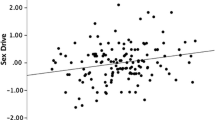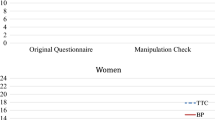Abstract
Male undergraduates completed the Bem Sex RoleInventory (BSRI) as they are (actual), as others thoughtthey should be (ought), as they thought they should beideally (ideal), and then rated the importance of each item. Discrepancy scores were derivedby subtracting actual from either ought (oughtdiscrepancy) or from ideal (ideal discrepancy) andweighting scores by the importance of each item. BSRImasculine items provided the basis for masculinitydiscrepancies, and filler items, for generaldiscrepancies. With only two or three exceptions,participants were Caucasian. Each man competed againsta bogus competitor on a computer version of the Taylorreaction-time aggression paradigm that yielded a measureof both overt (intensity of the noise blast putativelydelivered to the opponent) and covert (noise blastduration) aggression. Men with high masculine"ought" discrepancies engaged in morecovert-and not more overt — aggression than didlows, an effect not moderated by provocation level.Those with high masculinity scores were more overtly aggressive than werelow masculinity men.
Similar content being viewed by others
REFERENCES
Ashmore, R. D., Del Boca, F. K., & Bilder, S. M. (1995). Construction and validation of the Gender Attitude Inventory, a structured inventory to assess multiple dimensions of gender attitudes. Sex Roles, 32, 753–785.
Babl, J. D. (1979). Compensatory masculine responding as a function of sex role. Journal of Consulting and Clinical Psychology, 47, 252–257.
Beal, D. J., O'Neal, E. C. Ong, J., & Ruscher, J. B. (1998). The ways and means of interracial aggression: Modern racists' use of covert retaliation. Unpublished manuscript.
Bem, S. L. (1981). Bem sex-role inventory. Palo Alto, CA: Consulting Psychologists Press.
Berkowitz, L. (1998). Affective aggre ssion: The role of stress, pain, and negative affect. In R. G. Geen & E. Donnerste in (Eds.), Human aggression: Theories, research, and implications for social policy. San Diego, CA: Academic Press.
Björkqvist, K. (1994). Sex differences in physical, verbal, and indirect aggression: A review of recent research. Sex Roles, 30, 177–188.
Björkqvist, K., Osterman, K., & Lagerspetz, K. M. (1994). Sex differences in covert aggression among adults. Aggressive Behavior, 20, 27–33.
Brain, P. F., & Susman, E. J. (1997). Hormonal aspects of aggression and violence. In D. M. Stoff, J. Breiling, & J.D. Maser (Eds.),Handbook of antisocial behavior. New York: Wiley.
Bushman, B. J., & Baumeister, R. F. (in press). Threatened egotism, narcissism, self-esteem, and direct and displaced aggression: Does self-love or self-hate lead to violence? Journal of Personality and Social Psychology.
Eagly, A. H., & Steffen, V. J. (1986). Gender and aggressive behavior: A meta-analytic review of the social psychological literature. Psychological Bulletin, 100, 309–330.
Grossman, M., & Wood, W. (1992). Sex differences in emotional intensity: A social role explanation. Journal of Personality and Social Psychology, 65, 1010–1022.
Higgins, E. T. (1987). Self-discrepancy: A theory relating self and affect. Psychological Review, 94, 319–340.
Kogut, D., Langley, T., & O'Neal, E. (1992). Gender role masculinity and angry aggression in women. Sex Roles, 26, 355–368.
McDaniel, J., O'Neal, E., & Fox, E. (1971). Magnitude of retaliation as a function of the similarity of available responses to those employed by attacker. Psychonomic Science, 22, 215–217.
Mosher, D. L., & Sirkin, M. (1984). Measuring a macho personality constellation. Journal of Research in Personality, 18, 150–163.
Österman, K., Börkqvist, K., & Lagerspetz, K. M. J., with Kaukiainen, A., Landau, S. F., Fraczek, A., & Caprara, G. V. (1998). Cross-cultural evidence of female indirect aggression. Aggressive Behavior, 24, 1–8.
Taylor, S. L., O'Neal, E., Langley, T., & Butcher, A. (1991). Anger arousal, deindividuation, and aggression. Aggressive Behavior, 17, 193–206.
Taylor, S. P. (1967). Aggressive behavior and physiological arousal as a function of provocation and the tendency to inhibit aggression. Journal of Personality, 35, 297–309.
Wood, W., Christensen, P. N., Hebl, M. R., & Rothgerber, H. (1997). Conformity to sextyped norms, affect, and the self-concept. Journal of Personality and Social Psychology, 73, 423–535.
Zillmann, D. (1979). Hostility and aggression. Hillsdale, NJ: Erlbaum.
Rights and permissions
About this article
Cite this article
Weisbuch, M., Beal, D. & O'Neal, E.C. How Masculine Ought I Be? Men's Masculinity and Aggression. Sex Roles 40, 583–592 (1999). https://doi.org/10.1023/A:1018840130646
Issue Date:
DOI: https://doi.org/10.1023/A:1018840130646




